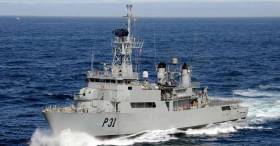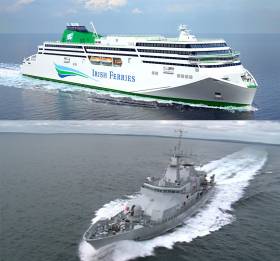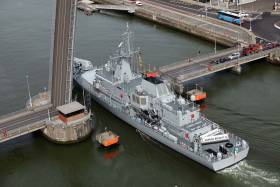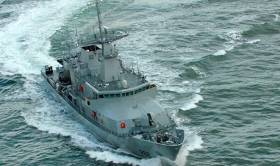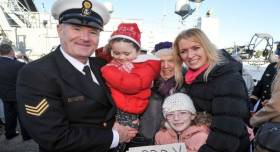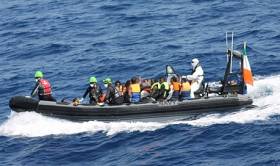Displaying items by tag: Navy
Government Package on Military Pay & Allowances Will Not Ease Naval Service Crew Shortage Which Has Tied Up Two Ships
Two of the State’s nine Naval Service fishery patrol vessels will remain tied up indefinitely, in spite of the 10.1 million euro annual package of military salary and allowance increases approved by Government yesterday writes Lorna Siggins.
The Government package which aims to address crew shortages, caused by military staff leaving for better paid jobs elsewhere, is due to be considered by defence force unions over the coming weeks.
However, a Defence Forces spokesman said that the two ships would remain docked, to ensure that there is sufficient cover to keep seven ships at sea on rotation.
Two ships, the LÉ Eithne helicopter patrol vessel which has been in service since 1984, and the LÉ Orla coastal patrol vessel in service since 1988, have been tied up.
In a statement, the Defence Forces press office said that the Flag Officer Commanding the Naval Service is “currently managing the consolidation of Naval Service assets”.
“This is due to ongoing personnel challenges”, it said and the defence forces’ commitment to “valuing our personnel, their welfare and safety”.
“Military authorities continue to examine all recommendations and options with the aim of maximising the effectiveness of the maritime defence and security operations carried out by the Naval Service,”it said.
“The Naval Service intends to consolidate its resources and redistribute its personnel to robustly man its assets. All ships will remain as fully commissioned military units with all of the associated administration and management in place,”the statement said.
Defence force unions had warned of the impact of pay and conditions, with Naval Service personnel forced to sleep on ships during time off due to a combination of low wages, high rents and lack of proper accommodation at the Naval Service headquarters in Cork harbour,
An Oireachtas committee was told last week that the Naval Service was in a “dire state”, with personnel “probably at its lowest level ever”.
The Naval Service fleet has grown from seven to nine ships in the past decade, and works with the Sea Fisheries Protection Authority on offshore fishery protection.
Its assets are expected to come under increasing pressure if there is a “no deal” Brexit, and EU vessels with quotas in British waters move into Irish waters.
The LÉ Orla and LÉ Ciara were both purchased from Britain, which had used them as coastal patrol vessels off Hong Kong. The LÉ Ciara will remain in service, along with the fleet’s six other ships,four of which were commissioned in the last five years.
The service’s most recently commissioned ship, the LÉ George Bernard Shaw, is the fourth in a P60 class of ships built by Babcock Marine Appledore shipyard in Devon.
Future of the Naval Service to be Reviewed
The operations of the Naval Service at its Headquarters on Haulbowline Island in Cork Harbour are to be reviewed, reports Tom MacSweeney.
This follows on the approval by Bord Pleanala of planning permission for the controversial hazardous waste incinerator at Ringaskiddy in the harbour area, which is adjacent to the Naval Base.
The Department of Defence had warned at the planning inquiry that the incinerator would have unacceptable effects on the Navy operations which would have national strategic implications.
The Minister of State at the Department of Defence, Paul Kehoe, replying to queries put to him, said that “the Defence Forces will review the An Bord Pleanála decision and its possible impact on Defence Force operations at Haulbowline ….”
Political and public reaction in Cork has expressed astonishment that the impact of a commercial company should be allowed to have any effect on the Naval Service.
The Minister said that “It would be inappropriate to make any comment until the review is complete..”
Why Has Irish Ferries Chosen The Same Name as the Navy?
Hello and you’re welcome to the weekly MacSweeney Podcast…
The procedures and practices involved in the naming of ships once appeared to be the product of evolution and tradition, then became the choice of politicians – at least as far as the Irish Naval Service is concerned - and of on-line polling where the ferry company, Irish Ferries, is involved.
So, there will be two vessels called after the poet William Butler Yeats……
The Naval Service’s L.E. William Butler Years - P63 - is the third of the recent additions to its fleet. Classed for offshore patrol, she cost €71m and was commissioned a year ago in Galway and named by a granddaughter of the poet.
Irish Ferries has decided to name its new €144m ferry, costing double the price of the Naval vessel and now being built in Germany, also after the poet who was born in Sandymount in Dublin and died in France…. The company says the name will be “important in overseas markets drawing a high degree of recognition” and that it chose ‘WB Yeats’ after an online competition which attracted 100,000 entries.
Managing Director Andrew Sheen said the name “continues the tradition adopted by the company of selecting names from the world of Irish literature.” The name, he said, will “sit comfortably alongside those other great literary figures whose names adorn other vessels in the Irish Ferries fleet” but some of which are registered outside of Ireland – in Cyprus and the Bahamas.
The Government decision, which was opposed by Naval officers past and present and by sections of public opinion, ended the tradition of naming Irish Navy patrol vessels after mythical female figures. It was controversial when the Cabinet ignored Naval opinion. The Department of Defence said the naming of ships after “world renowned literary figures” would “facilitate greater recognition for the Naval Service in the international maritime domain”.
On that score Irish Ferries’management seems to agree….
It is not uncommon in the shipping world for vessels to have similar names, but is generally avoided to prevent confusion. Two ships operating in Irish waters - named after the same Irish poet does invite questions – why – and will the duplication of names cause confusion?
So far, there’s been no comment from the Navy or the Department of Defence on the duplication…
Irish Naval Service Awarded Civic Honour of "Freedom of Entry" to Dun Laoghaire Rathdown County
In recognition of its international humanitarian service on behalf of the people of Ireland and the European Union, Dún Laoghaire-Rathdown County Council has decided to award the Irish Naval Service the civic honour of "Freedom of Entry" to the county.
The award will be conferred on the officers and crew of the LÉ Eithne at a special ceremony at 1pm on Friday 31st March at Harbour Plaza, Dún Laoghaire.
LÉ Eithne likewise of the seven-strong fleet has an adopted homeport, in the case of the Helicopter Patrol Vessel this is Dun Laoghaire Harbour. The HPV will be berthed during the ceremony at St. Micheals Wharf which is located just beyond the Harbour Plaza. From here there are views of the East Pier and in the distance Howth Peninsula.
Fourth Irish Naval Service Vessel To Be Named 'George Bernard Shaw'
The fourth Offshore Patrol Vessel (OPV) for the Irish Naval Service will bear the name of renowned Irish playwright George Bernard Shaw. The announcement was made during a traditional Keel Laying Ceremony, to mark a significant milestone being reached in the build process for the fourth new OPV, in Babcock’s Shipbuilding Yard in Devon, UK.
The Keel Laying ceremony was attended by the Minister with Responsibility for Defence, Mr. Paul Kehoe TD, senior representatives from Babcock, the Defence Forces and the Department of Defence, as well as Naval Service members involved in the build project.
The new ship will be the same class as LÉ Samuel Beckett, LÉ James Joyce and LÉ William Butler Yeats and the name George Bernard Shaw maintains the approach of naming this class of vessel after Irish literary greats.
Speaking at the ceremony Minister said “Whether it is carrying out defence and security operations, on sea fisheries patrols, search and rescue operations or on overseas missions such as the humanitarian operation in the Mediterranean, the efforts of the Naval Service are enhanced by having access to new vessels equipped with the latest available capabilities.
Reflecting on the relationship between the Defence organisation and Babcock which has already seen a number of the current in-service Irish Naval Service vessels built in the Appledore facility Minister Kehoe said
“The Government’s current ship replacement programme has delivered three Naval Service vessels, representing a significant investment by the Government in the provision of defence capability for the State. The ship that is being built at present will be the fourth in this class providing huge commonality benefits to the Naval Service and allowing for greater operational capacity.”
Minister Kehoe concluded by complimenting employees at Babcock “for their ability to produce well designed and stylish ships with state of the art equipment which have already proven their value to the Irish Naval Service both at home and on overseas missions.”
Coast Guard Helicopters Conducting Long Medical Evacuation Assisted by Naval Ship LÉ Roisin
The Shannon based Coast Guard helicopter Rescue 115 has evacuated a seriously injured crewman from a large Russian fishing vessel approximately 140 nautical miles West of Kerry Head.
The operation is being coordinated by the Marine Rescue Coordination Centre in Valentia and is being supported by the Naval ship LÉ Róisín. Crew members from the LÉ Róisín went on board the vessel and assisted with casualty evacuation. Communication support and back up, known as Top Cover was provided by a second Coast Guard helicopter, the Waterford based R117.
Weather conditions in the area for helicopter operations were difficult, bordering on marginal for such operations with a strong West South West swell and winds gusting in excess of 35mph.
The helicopter is currently routing to University Hospital Limerick, to arrive before 7:30pm, following an essential fuel stopover at Kerry airport.
This is the second operation in recent weeks where the LÉ Róisín assisted the Coast Guard in an operation at sea. Coast Guard helicopters are capable of operating out to 200 miles and operations of this nature are indicative of the professionalism of the Coast Guard Helicopter Rescue crews. The Coast Guard complimented the crew of the LÉ Róisín for their efficiency in operating a RIB (Rigid Inflatable Boat) in difficult conditions and for getting crewmembers onto the fishing vessel.
LÉ Roisin responded to a request to provide medical assistance and recover an injured fisherman approx 200 nautical miles off Loop Head. pic.twitter.com/AFmnT3Vl5G
— Irish Defence Forces (@defenceforces) February 21, 2017
Defence Force ‘Naval Service’ Review of 2016
#NavalReview - The Defence Forces in the year of 2016 have been tasked by the Government to play a central role in the 1916 Centenary Commemorative programme.
Notwithstanding the ceremonial activities performed during 2016, Óglaigh na hÉireann maintained operations, contributing to security both at home and internationally in 15 countries and one sea tasked to the Irish Naval Service.
Below is a sample of the breadth of activities undertaken by the Defence Forces (Review) in 2016 in which the Naval Service forms on of three branches the others been the Army and Air Corps.
Afloat has concentrated on highlighting the role of the Naval Service. No fewer than three OPV continued to play a pivotal role last year in overseas missions in search and rescue (SAR) of refugees and migrants in the central Mediterranean Sea off Libya.
*Statistics quoted are provisional to date and are subject to finalisation in the 2016 Annual Report which will be published in early 2017.
International Operations
The Defence Forces have the longest unbroken record of overseas service of any country in the world since first deploying to a United Nations mission in 1958. Some details of the Defence Forces contribution to international peace and security, on behalf of Ireland, are below:
In 2016 over 1400 Defence Forces personnel served in overseas Peace Support and Security operations in 15 countries and one sea. Currently over 600 Defence Forces personnel are serving in 15 countries.
The Defence Forces deployed three Naval ships (Afloat add they were L.E. Samuel Becket, L.E. James Joyce and L.E. Roisin) and over 150 Naval Service and Army personnel to the Mediterranean this year. This was in response to the humanitarian crisis supporting the Italian Marine Rescue Co-Ordination Centre with Search and Rescue assistance.
The total number of migrants rescued in 2016 by the men and women of Óglaigh na nÉireann was 7,029 and over 15,500 since operations began in 2015.
Domestic Operations
The Naval Service has completed over 1,200 boardings and made 3 detentions so far in 2016 for alleged infringements of fishing regulations, the Air corps conducted over 300 Maritime Surveillance Patrol flights.
The Naval Service & Air Corps patrol 220 million maritime acres of sea (over twelve times the land mass of Ireland) representing 15% of Europe’s fisheries.
Naval Service Dive Team were deployed 10 times in 2016 including seven separate Search and Recovery operations following requests from the Coast Guard and An Garda Síochána.
To also read more about the roles of the Army and Air Corps activities in the review click here.
#BeckettHome - In time for Christmas with an arrival home writes The Irish Examiner. Hugs, kisses, and a few tears of joy shed as the crew of the LÉ Samuel Beckett disembarked to be greeted by loved ones yesterday after 85 days on migrant rescue operations in the Mediterranean Sea.
However, many of the sailors will forever remember the horrors they witnessed off the coast of Libya, as merciless people-smugglers knowingly send migrants to a certain death if they’re not rescued.
Ship’s captain Lieutenant Commander Darragh Kirwan said he had no doubt the migrants crammed into inflatable rubber dinghies would never have made it to Italy.
On their first day of operations, six migrants drowned as the ship went to the rescue of a group packed into a dinghy.
“Around 25% of all inflatables we came across had punctured chambers. There isn’t enough food on board them and they are only given enough petrol for 50 miles. They [people smugglers] know they are sending people to their deaths,” the senior officer said.
To add to their woes, “jackals”, as the navy term them, often prey on the migrants at sea, stealing their outboard motors and personal valuables.
For much more on the Haulbowline homecoming click here
European Award to Defence Forces For Humanitarian Work
#EuropeAward - The Irish Defences Forces were presented The European of the Year award writes The Irish Times.
The award was given by the European Movement Ireland in recognition of the Defence Forces’ contribution to international peacekeeping and humanitarian work.
The award was presented at a ceremony on Monday in Dublin’s Shelbourne Hotel by Taoiseach Enda Kenny, who is honorary president of the Movement.
“The Defence Forces have a proud history of international service for Ireland and on behalf of the European Union and the United Nations, ” he said. “They are a very worthy recipient, especially this year, when, as well as their ongoing humanitarian and peace-keeping endeavours abroad, they have played a very prominent and important role in our 1916 Centenary commemorations.”
Approximately 385 Defence Forces personnel are serving overseas at present.
For the past two years, the Naval Service has been involved in Operation Pontus, supporting the Italian Marine Rescue Co-Ordination Centre which has been overseeing a multi-lateral effort at rescuing migrants crossing the Mediterranean Sea from north Africa.
Since May 2015, Defence Forces ships rescued over 15,000 would-be migrants attempting to cross the sea. The newapaper has more here.
Afloat adds that the awards ceremony took place also with yesterday's RTE One broadcast of 'The Crossing'
With unprecedented access, The Crossing tells story of one month in the LÉ Samuel Beckett’s deployment in the southern Mediterranean. It shows the reality for both the crew and the migrants as their worlds meet in the middle of the sea, often in the most difficult of circumstances. To view click this link to the RTE iplayer here.
Following the harrowing reality of The Crossing which examined the humanitarian mission of 'Operation Pontus' RTE also had a follow-up Claire Byrne Live Extras: Defence Forces in the Mediterranean. Minister of State at the Department of Defence, Paul Kehoe, actor Liam Cunningham who is a charity ambassador for World Vision and columnist Ian O’Doherty discuss the Irish response to the migrant crisis. Are we suitably equipped to take in large numbers of refugees and how do we treat migrants who have already arrived here?
To also view this current affairs programme click here.
LÉ Samuel Beckett which was deployed in September is to end its search and rescue missions and is due to return to Irish waters this Friday.
Supertrawler Boarded For Inspection Off Donegal
#Supertrawler - Naval Service personnel from the LÉ James Joyce have boarded a controversial fishing ‘supertrawler’ off the North West coast, according to the Donegal Democrat.
As previously reported on Afloat.ie, the 9,500-tonne FV Margiris — one of the largest fishing vessels in the world — prompted renewed fears among local fisherman and conservationists last week when it was spotted in fishing grounds off Donegal.
News of the Naval Service inspection has been welcomed by the Irish Wildlife Trust, though it cautioned on the need for a full-time inspection regime for such large-scale factory trawlers to ensure they are fishing legally and within quota, and not causing harm to protected wildlife such as dolphins.
The Donegal Democrat has more on the story HERE.



























